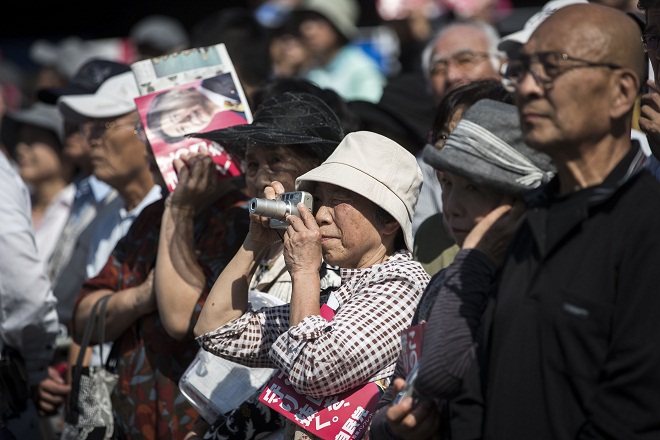Official campaign period begins for general election
October 10, 2017
TOKYO- The 12-day official campaign period kicked off on Tuesday for the crucial Oct. 22 general election for Japan's House of Representatives, with the administration of Prime Minister Shinzo Abe set to face voters' verdict nearly five years after it was launched.
A total of over 1,100 people are expected to run in the poll for the 465-seat powerful lower chamber of the Diet, the country's parliament. Of the overall seats, 289 are for single-seat constituencies and 176 for proportional representation blocs.
As of 3 p.m. (6 a.m. GMT), a total of 1,178 people filed their candidacies--934 for single-seat constituencies and 244 for proportional representation. Candidacies can be accepted by 5 p.m.
The election is a three-way battle among the pair of Abe's ruling Liberal Democratic Party and its partner, Komeito, the alliance of Tokyo Governor Yuriko Koike's Party of Hope and Nippon Ishin no Kai, and the camp of the Japanese Communist Party, the Constitutional Democratic Party of Japan and the Social Democratic Party.
The biggest focus is whether the electorate will allow the Abe administration to stay, with main campaign issues including constitutional revision and the advisability of going ahead with the consumption tax rate hike from 8 pct to 10 pct in October 2019 as planned by the government.
Making his first official campaign speech for the poll in the northeastern city of Fukushima, Abe stressed the LDP-Komeito pair's determination to tackle as a responsible ruling coalition the two main challenges facing the country--the aging population and low birthrate, and threats from North Korea.
"We'll honestly try to seek your understanding for our policies," Abe said. "What will open the way to the future is not a boom, nor a slogan," he said, apparently referring to recent realignment moves among opposition parties.
In her stump speech in Tokyo, Koike said, "Let's put an end to the politics dominated by Abe with your vote," seeking support for her party's campaign to topple the Abe government.
Komeito leader Natsuo Yamaguchi said in Iwamizawa in the northernmost prefecture of Hokkaido that the prime minister should work with leaders of other countries to resolve the North Korean issue after the LDP-Komeito ruling camp solidifies its footing through the general election.
In Sendai in the northeastern prefecture of Miyagi, CDPJ leader Yukio Edano said, "Let's change the current top-down politics to grassroots politics based on peoples' opinions."
JCP leader Kazuo Shii said in Tokyo, "The biggest problem for Japan is seeing Abe stay as prime minister."
Nippon Ishin chief Ichiro Matsui, also governor of Osaka Prefecture, western Japan, said in the city of Osaka, "Before a consumption tax hike, bureaucrats' way of spending must be reviewed."
After serving as prime minister for the first time for the year until September 2007, Abe started his second tenure in the post in December 2012 as the LDP dethroned the then Democratic Party of Japan from the government to win back power in the month's Lower House election.
The upcoming poll will be the first Lower House election since December 2014, which had 1,191 candidates for 475 seats. Jiji Press
Latest Videos
- THE UNTOLD STORY EXPERT INSIGHTS INTO THE UKRAINE
- NEGOTIATING A NEW ORDER US RUSSIA TALKS ON UKRAIN
- Ukraine: A Pawn in the Geopolitical Game? Will Trump Intervene?
- US VP VANCE CRITICIZES EUROPEAN DEMOCRACIES AT MUNICH SECURITY CONFERENCE
- UNCOVERING THE WEB OF DECEIT: CIA INFILTRATION OF THE MEDIA
- SHIFTING SANDS: TULSI GABBARD’S CONFIRMATION AND THE EVOLVING GLOBAL LANDSCAPE
- FAUCI SCANDAL: A THREAT TO GLOBAL HEALTH AND DEMOCRACY






